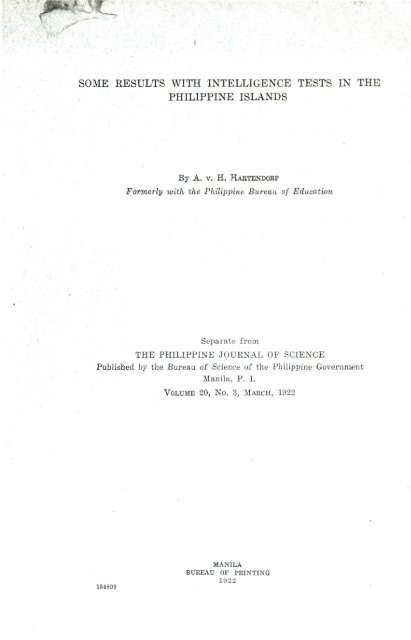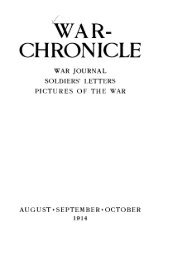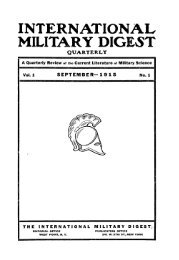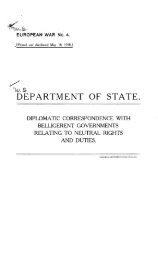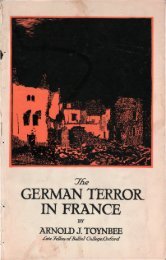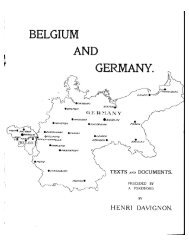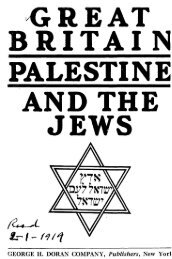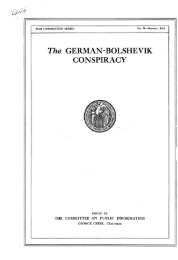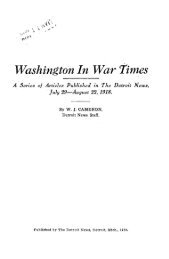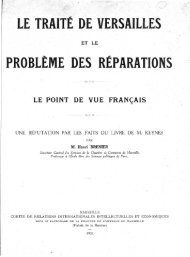SOME RESULTS WITH INTELLIGENCE TESTS IN THE PHILIPPINE ...
SOME RESULTS WITH INTELLIGENCE TESTS IN THE PHILIPPINE ...
SOME RESULTS WITH INTELLIGENCE TESTS IN THE PHILIPPINE ...
Create successful ePaper yourself
Turn your PDF publications into a flip-book with our unique Google optimized e-Paper software.
<strong>SOME</strong> <strong>RESULTS</strong> <strong>WITH</strong> <strong><strong>IN</strong>TELLIGENCE</strong> <strong>TESTS</strong> <strong>IN</strong> <strong>THE</strong><br />
PHILIPP<strong>IN</strong>E ISLANDS<br />
By A. v. H. HARTENDOBP<br />
Formerly with the Philippine Bureau of Education<br />
Separate from<br />
<strong>THE</strong> PHILIPP<strong>IN</strong>E JOURNAL OF SCIENCE<br />
Published by the Bureau of Science of the Philippine Government<br />
Manila, P. I.<br />
1848D9<br />
VOLUME 20, No. 3, MARCH, 1922<br />
MANILA<br />
BUREAU OF PR<strong>IN</strong>T<strong>IN</strong>G<br />
1922
<strong>THE</strong> PHILIPP<strong>IN</strong>E BUREAU OF SCIENCE<br />
CONTENTS AND <strong>IN</strong>DEX OF <strong>THE</strong> PHILIPP<strong>IN</strong>E JOURNAL OP SCIENCE,<br />
VOLUME I (1906) TO VOLUME X (1915)<br />
Order No. 449. Bureau of Science Publication No. 8. Paper, 441 pages.<br />
Price, $2 United States currency, postpaid.<br />
A CATALOGUE OF PHILIPP<strong>IN</strong>E COLEOPTERA<br />
By W. SCHULTZE<br />
Order No. 436. Bureau of Science Publication No. 7. Paper, 198 pages.<br />
Price, $1 United States currency, postpaid.<br />
A FLORA OF MANILA<br />
By E. D. MERRILL<br />
Order No. 419. Bureau of Science Publication No. 5. Paper, 490 pages.<br />
Price, $2.50 United States currency, postpaid.<br />
A MANUAL OF PHILIPP<strong>IN</strong>E BIRDS<br />
By RICHARD C. McQREQOR<br />
Order No. 103. Bureau of Science Publication No. 2. Paper, 769 pages.<br />
Price, $4 United States currency, postpaid.<br />
STUDIES <strong>IN</strong> PHILIPP<strong>IN</strong>E DIPTERA, II<br />
By M. BE2ZI<br />
Order No. 437, Bureau of Science Publication No. 10. Paper, 59 pages<br />
and 1 plate.<br />
Price, $0.50 United States currency, postpaid.<br />
PLEASE GIVE ORDER NUMBER<br />
Orders for Bureau of Science publications may be sent to the Business Manager, Philippine<br />
Journal of Science, Bureau of Science, Manila, P. I., or to any of the following agents:<br />
AGENTS<br />
<strong>THE</strong> MACMILLAN COMPANY, 64-66 Fifth Avenue, New York, U. S. A.<br />
WHELDON & WESLEY, Limited, 28 Essex Street, Strand, London, W. C, England.<br />
MART1NUS N1JHOFF, Large Voorhout 9, The Hague, Holland.<br />
KELLY & WALSH, Limited, 32 Raffles Place, Singapore, Straits Settlement».<br />
THACKER, SP<strong>IN</strong>K & CO., P. O, Box 54, Calcutta, India.<br />
<strong>THE</strong> MARUZEN CO., Limited, II-I6 Nlhonbaahl, Tori-Sanchome, Tokyo, Japan.
<strong>SOME</strong> <strong>RESULTS</strong> <strong>WITH</strong> <strong><strong>IN</strong>TELLIGENCE</strong> <strong>TESTS</strong> <strong>IN</strong> <strong>THE</strong><br />
PHILIPP<strong>IN</strong>E ISLANDS<br />
By A. V. H. HARTENDORP<br />
Formerly with the Philippine Bureau of Education<br />
EIGHT TEXT FIGURES<br />
The present paper consists of three parts. Part one gives<br />
the results of the application of the Otis group intelligence<br />
scale to 1,000 male and 752 female teachers in Tayabas, Batangas,<br />
Laguna, and Rizal Provinces. Part two gives the results<br />
of the same scale applied to 166 male and 59 female teachers<br />
from all parts of the Philippines, gathered in convention at<br />
Baguio. Part three gives the results of the application of the<br />
Yerkes point scale to 146 boys and 29 girls, many of them of<br />
mixed blood, in the Palawan Provincial School at Cuyo.<br />
PART ONE<br />
The Otis group intelligence scale was devised by Dr. Arthur<br />
S. Otis, of Leland Stanford Junior University, and was copyrighted<br />
by the World Book Company in 1919. It was one of the<br />
first and most satisfactory scales devised for testing subjects<br />
in groups. It is very similar in form to the Alpha examination<br />
adopted by the United States Army later. 1<br />
The Otis scale tests chiefly the higher mental processes, such<br />
as controlled association, analysis, logical judgment, synthesis,<br />
and generalization. Comprehension of language (English),<br />
memory, and imagination are, of course, also involved. Incident<br />
to the group method, in which the correct response (to<br />
be underlined by the subject) to each problem is suggested along<br />
with several incorrect responses—which makes possible a rapid<br />
scoring of the examination sheets by means of stencils—is the<br />
important element of recognition, but what Terman says of<br />
recognition in reading probably applies here:<br />
Eecognition is for the most part an associative process. Rapid and'<br />
accurate association will mean ready recognition of the printed form. 2 .<br />
Yoakum and Yerkes, Army Mental Tests. New York (1920) 2.<br />
* Terman, The Measurement of Intelligence. New York (1916) 265.<br />
287
288 The Philippine Journal of Science 1922<br />
Table 1 outlines the principal mental functions involved inmeeting<br />
the requirements in each separate test in the scale.<br />
TABLE 1.—Mental functions involved in Otis scale test.<br />
Test<br />
No.<br />
1<br />
2<br />
3<br />
4<br />
5<br />
6<br />
7<br />
g<br />
9<br />
10<br />
Requirement.<br />
Arranging disarranged<br />
sentences.<br />
Interpreting proverbs<br />
Solving arithmetical problems.<br />
Discriminating between<br />
geometric figures.<br />
Completing analogies<br />
Completing a narrative<br />
Principal mental functions involved.<br />
Comprehension of language, reaction according to instructions,<br />
inhibition of interfering associations and perseverations.<br />
Controlled association—which lies at the basis of the reasoning<br />
process.<br />
Ideation, vocabulary, memory, analysis, logical integrity of<br />
.the association process.<br />
Generalization, language.<br />
Arithmetical reasoning, attention.<br />
Visual discrimination, comparison, attention, comprehension<br />
of language.<br />
Logical judgment and analysis.<br />
Controlled association—"Thinking means essentially the association<br />
of ideas on the basis of differences and similarities."<br />
»<br />
Synthesizing ability—"Intelligence is essentially a combinative<br />
activity," b memory, association.<br />
Logical or substance memory, immediate memory for ideas.<br />
language, "Language growth mirrors the entire mental<br />
development ... it is the sine qua non of conceptual<br />
thinking," c suggestibility.<br />
» Terman, The Measurement of Intelligence. New York (1916) 202.<br />
» Whipple, Manual of Mental and Physical Tests. Baltimore (1914) 649.<br />
« Terman, op. cit. 265.<br />
Table 2 shows the total number of scores made by the provincial<br />
teachers, and the number of men and women making<br />
each score. The average score for the men is 77.0 and for the<br />
women 70.9.<br />
Fig. 1 shows graphically the data that are recorded in Table 2.<br />
The class interval is ten points. The regularity of the curves<br />
for the men and the women, and the fairly constant relation<br />
between the two, indicate that enough data were obtained to<br />
give representative results.<br />
Table 3 gives the average scores made by the teachers in the<br />
different provinces, which are all Tagalog.<br />
Prof. H. Otley Beyer, of the University of the Philippines,<br />
says the following concerning the Tagalog group of Philippine<br />
peoples :<br />
Number, 1,789,049; the second largest Philippine group and the highest<br />
in cultural development. Loo.: The great majority of .the Tagalogs are<br />
found in Luzon, where they form the greater part of the population in the<br />
following provinces: Tayabas, Batangas, Cavité, Laguna, Rizal, Manila<br />
city, Bataan, Bulacan, and Nueva Ecija. Considerable numbers are also
2o,s Hartendorp:.Some Results with Intelligence Tests 289<br />
#<br />
TABLE 2.—Showing all scores made by the provincial teachers and the<br />
number of men and women making them.<br />
8<br />
10<br />
13<br />
15<br />
16<br />
18<br />
20<br />
21<br />
22<br />
24<br />
25<br />
26<br />
27<br />
28<br />
29<br />
30<br />
Score.<br />
31 «.<br />
32<br />
33<br />
34<br />
35<br />
36<br />
37<br />
38<br />
89<br />
40<br />
41 -<br />
42<br />
43<br />
44<br />
45<br />
4R<br />
47<br />
48<br />
49<br />
50<br />
51...<br />
52<br />
53<br />
54<br />
55<br />
56<br />
57<br />
58<br />
59<br />
60<br />
[B, Batangas; L, Laguna; R, Rizal; T, Tayabas.]<br />
Nun iber.<br />
Male.<br />
B 1<br />
L 1<br />
L 1<br />
B 1<br />
L 1<br />
2<br />
2<br />
1<br />
1<br />
1<br />
3<br />
3<br />
1<br />
2<br />
3<br />
3<br />
2<br />
4<br />
7<br />
7<br />
3<br />
8<br />
7<br />
3<br />
5<br />
5<br />
14<br />
6<br />
11<br />
3<br />
7<br />
8<br />
10<br />
9<br />
13<br />
16<br />
7<br />
7<br />
9<br />
11<br />
14<br />
12<br />
13<br />
11<br />
16<br />
Female.<br />
T 1<br />
R 1<br />
T 1<br />
R,T 2<br />
4<br />
1<br />
2<br />
2<br />
1<br />
2<br />
3<br />
4<br />
4<br />
8<br />
4<br />
4<br />
4<br />
2<br />
7<br />
6<br />
3<br />
4<br />
5<br />
5<br />
6<br />
6<br />
7<br />
8<br />
17<br />
9<br />
8<br />
7<br />
12<br />
10<br />
8<br />
11<br />
13<br />
10<br />
7<br />
10<br />
14<br />
11<br />
13<br />
61<br />
62.1<br />
63-<br />
64<br />
65...<br />
66<br />
67<br />
68<br />
69<br />
70<br />
71<br />
72<br />
73<br />
74<br />
75<br />
78<br />
77<br />
Score.<br />
78 *.<br />
79<br />
80<br />
81-<br />
82<br />
83<br />
84<br />
86<br />
86<br />
87<br />
88<br />
89<br />
90<br />
91<br />
92<br />
93<br />
. 94 $.__<br />
95<br />
96<br />
97<br />
98-<br />
99<br />
100<br />
101<br />
102<br />
103<br />
104<br />
105<br />
106<br />
107<br />
Nun iber.<br />
Male.<br />
14<br />
14<br />
11<br />
16<br />
12<br />
18<br />
16<br />
17<br />
12<br />
14<br />
21<br />
16<br />
16<br />
18<br />
26<br />
14<br />
15<br />
16<br />
10<br />
18<br />
15<br />
18<br />
9<br />
12<br />
15<br />
9<br />
15<br />
12<br />
15<br />
13<br />
8<br />
8<br />
10<br />
13<br />
16<br />
8<br />
15<br />
9<br />
9<br />
9<br />
15<br />
7<br />
2<br />
6<br />
8<br />
7<br />
7<br />
Female.<br />
14<br />
20<br />
9<br />
13<br />
11<br />
10<br />
13<br />
18<br />
11<br />
10<br />
16<br />
10<br />
2<br />
23<br />
8<br />
7<br />
11<br />
8<br />
12<br />
11<br />
12<br />
14<br />
10<br />
11<br />
6<br />
11<br />
12<br />
2<br />
8<br />
9<br />
5<br />
7<br />
6<br />
5<br />
9<br />
8<br />
4<br />
5<br />
11<br />
6<br />
9<br />
4<br />
3<br />
3<br />
6<br />
4<br />
3<br />
108...<br />
109<br />
110<br />
Ill<br />
112<br />
113<br />
114<br />
Score.<br />
115<br />
116 _<br />
117<br />
118<br />
119<br />
120<br />
121—<br />
122<br />
123<br />
124<br />
125<br />
126<br />
127<br />
128<br />
129<br />
130<br />
131<br />
132<br />
133<br />
134<br />
136<br />
137<br />
138<br />
139<br />
140<br />
141<br />
142<br />
144<br />
147<br />
149<br />
160<br />
151<br />
153—_<br />
154<br />
156<br />
161<br />
163<br />
167<br />
171<br />
Total<br />
Nun iber.<br />
Male.<br />
7<br />
6<br />
7<br />
4<br />
3<br />
4<br />
6<br />
5<br />
8<br />
6<br />
1<br />
7<br />
2<br />
3<br />
9<br />
2<br />
2<br />
2<br />
4<br />
2<br />
3<br />
1<br />
1<br />
2<br />
1<br />
3<br />
2<br />
5<br />
1<br />
2<br />
1<br />
1<br />
2<br />
T,B 2<br />
T 1<br />
T 1<br />
R 1<br />
L 1<br />
L 1<br />
R 1<br />
1,000<br />
Female.<br />
6<br />
5<br />
2<br />
2<br />
1<br />
2<br />
3<br />
3<br />
2<br />
5<br />
2<br />
1<br />
3<br />
1<br />
2<br />
• 2<br />
1<br />
2<br />
5<br />
1<br />
1<br />
1<br />
L 1<br />
L 1<br />
R 1<br />
T 1<br />
L 1<br />
L 1<br />
L 1<br />
752
290 The Philippine Journal of Science 1922<br />
10 20 30 40 50 60 70 60 90 100 110 120 130 140 150 160 170 180<br />
Score.<br />
Fia. 1. The percentile distribution of scores for men and women—provincial group.<br />
TABLE 3.—Showing the average scores made by teachers in the several<br />
Tagalog provinces.<br />
Province.<br />
Batangas<br />
Rizal<br />
Total<br />
Total<br />
Number.<br />
152<br />
366<br />
257<br />
225<br />
1,000<br />
176<br />
209<br />
203<br />
164<br />
752<br />
1<br />
8.4<br />
7.9<br />
7.6<br />
8.1<br />
7.9<br />
7.4<br />
7.4<br />
7.5<br />
7.5<br />
7.5<br />
2<br />
9.7<br />
11.4<br />
9.6<br />
9.1<br />
10.2<br />
11 3<br />
9.4<br />
8.0<br />
8.4<br />
9.3<br />
3<br />
10.8<br />
8.4<br />
8.2<br />
8.3<br />
8.7<br />
MEN.<br />
W OMElv<br />
9.0<br />
8.0<br />
8.7<br />
6.9<br />
8.2<br />
i<br />
3.7<br />
4.7<br />
4.0<br />
3.3<br />
4.0<br />
4.3<br />
3.6<br />
2.3<br />
2.6<br />
3.2<br />
5<br />
9.9<br />
8.7<br />
9.3<br />
10.3<br />
.<br />
9.4<br />
7.3<br />
7.9<br />
8.4<br />
8.4<br />
8.0<br />
6<br />
6.4<br />
6.0<br />
5.9<br />
6.3<br />
6.1<br />
5.5<br />
5.6<br />
5.6<br />
5.6<br />
5.6<br />
7<br />
7.4<br />
5.7<br />
7.2<br />
7.1<br />
6.7<br />
5.1<br />
6.0<br />
6.7<br />
6.5<br />
6.1<br />
8<br />
7.3<br />
6.1<br />
6.6<br />
6.8<br />
6.6<br />
5.3<br />
6.9<br />
7.1<br />
6.6<br />
6.2<br />
9<br />
8.2<br />
8.8<br />
6.8<br />
6.4<br />
7.6<br />
8.6<br />
7.7<br />
6.7<br />
5.8<br />
7.2<br />
10<br />
11.0<br />
9.5<br />
10.0<br />
9.4<br />
9.8<br />
9.4<br />
9.9<br />
9.3<br />
10.0<br />
9.6<br />
Total.<br />
82.8<br />
77.2<br />
75.2<br />
75.1<br />
77.0<br />
73.2<br />
71.3<br />
70.3<br />
68.3<br />
found in northern Camarines, Tarlac, and southern Zambales. In addition<br />
to Luzon, the island of Marinduque is wholly Tagalog, while Masbate is<br />
partly so, and the coastal region of th% northern two-thirds of Mindoro.<br />
A few individuals are to be found in practically every province of the<br />
Islands, while numbers have emigrated to the United States, Hawaii, Japan,<br />
the China Coast, and other foreign lands. Char.: Christian; and possessing<br />
the general Spanish-Filipino civilization of the lowland people. In a majority<br />
of the Tagalog provinces the predominating physical type is a Malay<br />
blend with the short and tall Mongol elements exceedingly prominent. The<br />
chief exceptions are the provinces of Batangas, Cavité, and a few minor<br />
localities, where the Indonesian element is most in evidence. . . The<br />
people of the coastal regions are much mixed and tall types predominate,<br />
while those of the interior are more uniform and short types are common. 8<br />
* Beyer, H. O., Population of the Philippine Islands in 1916. Manila,<br />
Philippine Education Co. (1917) 70-71.<br />
70.9
20,3 Hartendorp: Some Results with Intelligence Tests 291<br />
It should be understood that Beyer recognizes the following<br />
racial types in the Philippine Islands :<br />
Three dwarf types.— (1) The aboriginal Negrito—short,<br />
slender, very dark, frizzly-haired, body hairless, face Negroid;<br />
(2) a very old Australoid Ainu mixture—short, stocky, light,<br />
hairy, early gray, face Caucasian; and (3) the Proto-Malay—<br />
short, stocky, dark, body hairless, face Mongoloid, nose short<br />
and immobile, eyes prominent, third lid, wide apart.<br />
Three tall types.—(1) The Malay—slender, brown, face flat<br />
and oval, probably an early and progressive Chinese-Indonesian<br />
mixture; (2) the Indonesians, which are divided into three subtypes—<br />
(A) tall, slender, light, Caucasian features; (B) tall,<br />
heavier, dark, Semitic features; and (C) tall, heavy, very dark,<br />
Negroid features; and (3) the Papuan—true Negro type. 4<br />
Table 3 shows some exceedingly interesting provincial differences.<br />
There is a difference of twelve points in the average<br />
total score for the men and women of Rizal, whereas the sex<br />
difference in the other provinces is much less.<br />
There exist some striking differences in physical type between<br />
the men and the women of the same groups in various localities<br />
in the Philippines. Among the Ifugaos, for example, the men<br />
belong in general to the Malay blend type, while the women belong<br />
clearly to the Proto-Malay type. It seems, in other words,<br />
that the women represent in physical type the older mountain<br />
people who were conquered by the later Malay invaders, who<br />
imposed upon them their general culture, and their physical type<br />
upon their sons, but who could produce apparently no change<br />
in the appearance of the women and their daughters in some<br />
sixteen centuries.<br />
The same thing is probably true in Rizal. At one time there<br />
existed a great Chinese settlement in Mariquina Valley. Now,<br />
possibly not only physically, but mentally, the women represent<br />
the older/ more primitive type of the province, while the men represent<br />
the more recent and the more intelligent Chinese element.<br />
Tayabas ranks most consistently high for both men and women.<br />
Tayabas was but lightly populated when the Spaniards came to<br />
the Islands in the sixteenth century. Many of the present inhabitants<br />
and their descendants emigrated within the last one<br />
hundred years from Laguna, Bulacan, and Nueva Ecija. The<br />
people of Tayabas represent, therefore, a progressive and venturesome<br />
people.<br />
* See Beyer's article in The Census of the Philippine Islands for 1918<br />
2 (1921) 907-957.
292 The Philippine Journal of Science îm<br />
The prevalent type in Laguna is the tall, light Malay blend.<br />
There has been considerable intermixture with Chinese, and<br />
some Spanish intermixture.<br />
The Batangas teachers scored lowest. The Batangas type is<br />
a Malay blend, but with the Indonesian B element very prominent.<br />
There has been less intermixture with foreign blood than in the<br />
other provinces.<br />
Table 4 gives the averages for these teachers taken in groups<br />
of educational attainment. The figures are significant.<br />
TABLE 4.—Showing average scores of the provincial teachers taken in<br />
groups of educational attainment.<br />
Group.<br />
FQ. C. D., Quartile coefficient of dispersion.]<br />
Below seventh grade<br />
Intermediate graduates<br />
First-year high school and normal school<br />
Second-year high Bchool and normal school-, __<br />
Third-year high school and normal school<br />
Fourth-year and graduate high school<br />
College graduates and undergraduates<br />
Total<br />
Number.<br />
50<br />
609<br />
196<br />
83<br />
38<br />
83<br />
28<br />
13<br />
1,000<br />
Men.<br />
Score.<br />
66.9<br />
70.5<br />
73.5<br />
85.6<br />
93.4<br />
103.0<br />
115.6<br />
110.5<br />
a. C.D.<br />
0.28<br />
0.16<br />
0.25<br />
0.21<br />
0.13<br />
0.16<br />
0.16<br />
0.17<br />
Number.<br />
53<br />
498<br />
125<br />
39<br />
6<br />
23<br />
88<br />
752<br />
Women<br />
Score.<br />
53.4<br />
69.1<br />
70.8<br />
85.5<br />
95.0<br />
109.3<br />
113.6<br />
Q. C. D.<br />
0.30<br />
0.25<br />
0.21<br />
0.19<br />
0.19<br />
0.21<br />
0.16<br />
It must not be forgotten that the Otis scale is an intelligence<br />
scale. It is not a test of knowledge.<br />
Intelligence is the capacity of the mind; and knowledge is the raw<br />
material that is put into the mind. 5<br />
Stern says:<br />
The tests do actually reach and discover the general developmental<br />
conditions of intelligence and not mere fragments of knowledge and attainments<br />
acquired by chance. 8<br />
• Terman says that school instruction is impotent to neutralize<br />
individual differences in native endowment. 7 Yerkes, in a study<br />
of the intelligence of university students and of mill operatives,<br />
in which he found the former superior, says : •<br />
5<br />
Piatt, R. H., Measuring minds, World's Work (Sept. 1920).<br />
6<br />
Stern, Psychological Methods of Testing Intelligence. Baltimore (1914)<br />
49.<br />
' Terman, The Measurement of Intelligence. New York (1916) 116.
Hartendorp: Sqme Results with Intelligence Tests 293<br />
It seems extremely improbable that this superiority is in any considerable<br />
measure due to higher education. 8<br />
It would be wrong to affirm that schooling has no influence<br />
at all upon the intelligence score, especially in the case of Filipinos<br />
who are given the test in the English language; for, although<br />
the Filipinos in question speak English and teach in<br />
English schools, they are, of course, less familiar with the<br />
language than American teachers. However, it will be shown<br />
later that this influence must not be overemphasized even in<br />
this case. A very considerable difference in average intelligence<br />
will be noted between seventh-grade and college graduates (see<br />
Table 4). It is much more likely that the teachers of lower<br />
educational attainments would have been unable to continue<br />
their education in the higher classes successfully. The C, or<br />
average grade of intelligence, in this case represented by a score<br />
from 52 to 81, "is rarely capable of finishing a high school<br />
course." 9<br />
The large gap between the average score of the teachers who<br />
had completed the intermediate school and those who had completed<br />
the first-year high-school course—73.5 and 85.6, boys<br />
only (teachers in the Bureau of Education rate their "attainment"<br />
as one year in advance of the year actually completed) —<br />
is probably of great significance in the matter of the high<br />
"mortality" in the first-year high-school class in the Philippines.<br />
About half of the students fail each year.<br />
The fact that the normal-school graduates rank higher than<br />
the high-school graduates may be explained by the fact that,<br />
while normal-school graduates are definitely destined for the<br />
TABLE 5.—Showing equivalent scores in the army tests and the Otis scale.<br />
Letter<br />
rating.<br />
A____<br />
B____ Superior intelligence _<br />
C+-.<br />
C—.<br />
c—..<br />
D-.. Inferior intelligence<br />
D—~<br />
Army<br />
test.<br />
135-212<br />
105-184<br />
75-104<br />
45-74<br />
26-44<br />
16-24<br />
0-14<br />
Otis<br />
scale.<br />
142-230<br />
112-141<br />
82-111<br />
52-81<br />
32-61<br />
22-31<br />
0-21<br />
8 Yerkes, Bridges, and Hardwick, Point Scale for Measuring Mental<br />
Ability. Baltimore (1915) 93.<br />
' Yoakum and Yerkes, Army Mental Tests. New York (1920) 23.
294 The Philippine Journal of Science 1922<br />
teaching profession, most high-school graduates of high ability<br />
go into other and more remunerative employment.<br />
Table 6 is a comparison of the results obtained with the Alpha<br />
examination in the United States Army and the Filipino teachers.<br />
It is based on the following table of equivalent scores taken from<br />
a recent circular of the World Book Company.<br />
TABLE 6.—Showing intelligence of American soldiers and Filipino teachers.<br />
Letter<br />
A.—<br />
B-...<br />
C+<br />
C—c—<br />
D.—<br />
D—<br />
Superior<br />
Meaning.<br />
Percentage<br />
of<br />
American<br />
draft<br />
quota.»<br />
4-5<br />
8-10<br />
15-18<br />
25<br />
20<br />
15<br />
Percentage<br />
of Fi<br />
lipinoprovincial<br />
teachers<br />
(men).<br />
1.0<br />
9.2<br />
29.9<br />
42.9<br />
14.3<br />
2.0<br />
0.7<br />
* The figures for the United States Army were taken from "Army Mental Tests" which<br />
has been quoted several times before.<br />
The Filipino group contains comparatively few men of very<br />
superior intelligence, but a higher percentage of high average<br />
and average, and a lower percentage of inferior and very inferior.<br />
The lower end of the table may be explained by the fact that<br />
the Filipino group was a selected one while the United States<br />
draft group was not. On the other hand, the smaller percentage<br />
of men of very superior ability in the Filipino group may be<br />
explained in part by the fact that many English-speaking Filipinos<br />
of ability do not enter the Government service in as much<br />
as private firms often offer more attractive salaries.<br />
PART TWO<br />
Table 7 shows the results obtained by applying the Otis scale<br />
to the 166 male and 59 female teachers from all parts of the<br />
Islands gathered in convention at Baguio, the summer capital<br />
of the Philippines. The more careful selection is at once apparent.<br />
The average for the men is 122.0 and for the women<br />
115.0.<br />
Fig. 2 gives graphically the data recorded in Table 7. Owing<br />
to the small number of individuals tested and the consequent<br />
irregularity of a curve drawn on smaller class intervals, the<br />
class interval in this case was made twenty points.
20,3 Hartendorp: Some Results with Intelligence Tests 295<br />
ti<br />
^ -n<br />
IB<br />
„ - • "'"<br />
,-~ s£~y<br />
—""<br />
,-'<br />
\ \<br />
60 60 100 120 140 160 180<br />
Score.<br />
PIG. 2. Percentile distribution of scores for men and women—Bajruio group.<br />
TABLE 7.—Showing all the scores of male cmd female teachers in the Baguio<br />
group.<br />
Score.<br />
54<br />
58<br />
61<br />
62<br />
71<br />
75<br />
77<br />
78<br />
79 _.<br />
80<br />
82<br />
83<br />
84<br />
85<br />
86<br />
88<br />
90<br />
91<br />
92.. -<br />
93<br />
95 -<br />
96<br />
97<br />
99<br />
100<br />
101<br />
102 r.<br />
103<br />
104<br />
105<br />
Nam ber.<br />
Mate.<br />
6<br />
2<br />
1<br />
2<br />
Female.<br />
1<br />
1<br />
1<br />
1<br />
2<br />
2<br />
1<br />
2<br />
3<br />
1<br />
1<br />
1<br />
1<br />
1<br />
1<br />
Score.<br />
106 .....<br />
107<br />
108-<br />
109<br />
110<br />
Ill<br />
112<br />
113<br />
114<br />
115<br />
116 —<br />
117<br />
118.<br />
119 -<br />
120 -<br />
121<br />
122.<br />
123<br />
124 — -<br />
1 125.<br />
126<br />
127<br />
128<br />
129<br />
130—<br />
181<br />
132<br />
183<br />
134<br />
135<br />
Nom jer.<br />
Male.<br />
1<br />
3<br />
2<br />
2<br />
8<br />
2<br />
4<br />
6<br />
4<br />
2<br />
6<br />
2<br />
2<br />
1<br />
3<br />
3<br />
2<br />
8<br />
3<br />
6<br />
2<br />
1<br />
4<br />
5<br />
1<br />
6<br />
2<br />
4<br />
2<br />
1<br />
Female.<br />
8<br />
1<br />
1<br />
1<br />
3<br />
2<br />
2<br />
1<br />
1<br />
2<br />
1<br />
3<br />
2<br />
Score.<br />
136<br />
137<br />
138<br />
139<br />
140<br />
141<br />
142<br />
143—<br />
144<br />
146 -<br />
146<br />
147 —<br />
148<br />
149 _.<br />
160<br />
152 _<br />
153<br />
154<br />
155<br />
156<br />
157<br />
158<br />
161<br />
162<br />
163<br />
164.<br />
166 _<br />
171<br />
183<br />
189<br />
Total<br />
*-<br />
Num ber.<br />
Male.<br />
2<br />
2<br />
2<br />
1<br />
2<br />
2<br />
1<br />
2<br />
1<br />
2<br />
S<br />
2<br />
1<br />
1<br />
2<br />
1<br />
2<br />
1<br />
1<br />
1<br />
2<br />
1<br />
1<br />
1<br />
2<br />
1<br />
1<br />
1<br />
166<br />
Female.<br />
Table 8 gives the averages for the teachers taken in groups<br />
of educational attainment. The comparison between this table<br />
and Table 4 is very interesting. While the difference between<br />
the lowest and highest educated groups among the provincial<br />
184895-<br />
4<br />
1<br />
2<br />
1<br />
1<br />
1<br />
1<br />
1<br />
1<br />
1<br />
1<br />
1<br />
69<br />
I
296 The Philippine Journal of Science 1922<br />
TABLE 8.—Showing average scores of Baguio teachers taken in groups of<br />
educational attainment.<br />
[Q. C. D., Quartile coefficient of dispersion.]<br />
Group.<br />
First-year high school and normal school<br />
Second-year high school and normal school<br />
Total -<br />
Number.<br />
46<br />
13<br />
11<br />
47<br />
16<br />
38<br />
166<br />
Men.<br />
Score.<br />
112.1<br />
116.0<br />
116.1<br />
128.2<br />
129.7<br />
129.9<br />
Q.C.D.<br />
0.10<br />
0.11<br />
0.19<br />
0.13<br />
0.08<br />
0.13<br />
Number.<br />
18<br />
3<br />
7<br />
22<br />
4<br />
5<br />
59<br />
Women.<br />
Score.<br />
95.5<br />
126.3<br />
115.0<br />
125.9<br />
106.7<br />
136.8<br />
Q.C.D.<br />
0.19<br />
0.22<br />
0.09<br />
0.07<br />
0.04<br />
teachers amounted to more than 50 points, this difference in<br />
the Baguio group amounts to but some 17 points (men only).<br />
First-year high- and normal-school men in the provincial group<br />
scored 73.5, while the same group among the Baguio teachers<br />
scored 112.1. The teachers who convene annually at Baguio<br />
are among the best teachers in the service. They are carefully<br />
selected by their respective division superintendents and sent<br />
to Baguio at Government expense to take part in various conferences<br />
and to learn of new ideas and methods in education.<br />
Tables 4 and 8 would seem to prove that schooling has but a<br />
slight influence, even among Filipinos, on the scores obtained<br />
in tests of native mental ability.<br />
TABLE 9.—Showing average i 'cores o f varioii ^ racia I types--Baguic<br />
Spanish-mestizo<br />
Type.<br />
Number.<br />
62<br />
19<br />
40<br />
10<br />
19<br />
Men.<br />
Range.<br />
54-183<br />
111-162<br />
84-161<br />
85-166<br />
97-189<br />
Average<br />
score.<br />
121<br />
121<br />
125<br />
127<br />
132<br />
Numbér.<br />
32<br />
4<br />
7<br />
Women.<br />
Range.<br />
62-158<br />
128-157<br />
88-171<br />
group.<br />
Average<br />
score.<br />
The Baguio group was too small and too carefully selected<br />
to bring to light facts of general applicability. However, each<br />
individual was classified as to his physical or racial type. Many<br />
of the individuals were much mixed, racially, and the classification,<br />
therefore, was far from satisfactory. But the average<br />
scores of the various racial types are given in Table 9, not so<br />
much to indicate the relative intelligence of these - Philippine<br />
116<br />
140<br />
129
20,3 • Hartendorp: Some Results with Intelligence Tests 297<br />
racial types, but to show that each type contains individuals<br />
of high mental ability. The table is given for what it is worth.<br />
Direct comparison between the scores obtained in the Otis<br />
scale by Americans and Filipinos would hardly be fair, owing<br />
to the different conditions; but, for the sake of completeness,<br />
the following American norms are given :<br />
Year.<br />
8<br />
9<br />
10<br />
11<br />
12<br />
13<br />
14<br />
15<br />
16<br />
17<br />
18<br />
In a letter to me Doctor Otis says :<br />
Score.<br />
40<br />
52<br />
64<br />
76<br />
88<br />
100<br />
112<br />
121<br />
125<br />
128<br />
130<br />
The normal intelligence for adults is considered to be constant for all<br />
ages above 18 years and is represented by a score of 130 points. Teachers<br />
are considered to be a group above "average" in intelligence and will range<br />
from 100 to 200 points in their scores.<br />
28<br />
26<br />
20<br />
4 16<br />
-ft<br />
/<br />
//<br />
Hig pest<br />
;guio<br />
\<br />
^s<br />
k<br />
Gro J<br />
P<br />
^ S<br />
m / \<br />
.--'' ^ ^5;<br />
''Pre vine a! G •oup \\<br />
^ > N *< r .<br />
\è Lim ts of See le<br />
K<br />
\<br />
/'<br />
/ /<br />
^<br />
Y\<br />
\S y /<br />
/'<br />
//<br />
\N \<br />
Ss<br />
f \<br />
/<br />
/<br />
/<br />
/<br />
//<br />
/<br />
/ /<br />
~-x<br />
n i H ¥ ¥i m m<br />
Test.<br />
FIG. 3. Average scores in each test separately.<br />
-A ^<br />
K<br />
298 The Philippine Journal of Science • 1922<br />
Fig. 3 is a profile graph showing the average performance<br />
of both groups in each individual test, for both males and females.<br />
It will be seen that both groups scored comparatively<br />
low in test 4, which is a test in the interpretation of proverbs.<br />
The language element, however, and English idiomatic expression<br />
is too considerable an element in this test to make it a fair<br />
one for Filipinos. In spite of this fact the results obtained with<br />
this test bear a high correlation with the general intelligence<br />
score. The same is true of test 7, completing analogies. The<br />
results obtained with test 3, arranging disarranged sentences,<br />
and with test 6, discriminating between geometric figures, show<br />
a lesser correlation with the general intelligence score.<br />
In regard to the relation between the scores of the men and<br />
those of the women it appears that the same is true in the<br />
Philippines as elsewhere. It will be seen that the difference is<br />
least in the tests which involve memory to any large extent.<br />
Yerkes and Burtt concluded—<br />
College men with respect to the majority of the intellectual functions<br />
measured by the point scale method, rank higher than college women<br />
* * * This superiority of the men is especially marked in tests which<br />
involve reasoning and other fairly complex thought processes."<br />
PART THREE<br />
Part three of this paper gives the results of the application<br />
of the Yerkes point scale " to a number of school children in<br />
the Provincial Intermediate and High School at Cuyo, Palawan.<br />
The point scale consists of twenty separate tests, each of<br />
which involves the mental functions enumerated in Table 10.<br />
The point scale was slightly adapted as follows :<br />
Test 9: "Orange" substituted for "apple," for the apple is<br />
not a tropical fruit; "iron" substituted for "glass," for glasa<br />
is not common in Cuyo. Test 14 : "Cuyo" substituted for "Boston,"<br />
and "ocean" for "river," for Cuyo cannot boast of a river.<br />
Test 15 : "Missing the boat" substituted for "missing the train,"<br />
for few Cuyono children had ever seen anything but the picture<br />
of a train. Test 20 : "Foot is to shoe" substituted for "hand is<br />
to glove," for gloves are about as common in Cuyo as fans in the<br />
Arctic region.<br />
Cuyo is a small island, some 8 by 11 kilometers, in the Sulu<br />
"Yerkes and Burtt, The Relation of Point-Scale Measurements of<br />
Intelligence to Educational Performance in College Students, School and<br />
Society (May 5, 1917).<br />
n Yerkes, Bridges, and Hardwick, A Point Scale for Measuring Mental<br />
Ability. Baltimore (1915).
20,3 Hartendorp: Some Results with Intelligence Tests 299<br />
Test.<br />
1<br />
2<br />
3<br />
4<br />
5<br />
6<br />
7<br />
8<br />
9<br />
10<br />
11<br />
12<br />
13<br />
14<br />
15<br />
16<br />
17<br />
18<br />
19<br />
20<br />
Memory __<br />
Auditory memory<br />
EinBesthetic discrimination __ __<br />
Imagination and command of<br />
language forma.<br />
do<br />
TABLE 10.—The point scale tests.<br />
Pr incipal mental functions.<br />
Perception, association, analysis.<br />
For words, attention.<br />
Imagination, attention.<br />
For sentences, attention.<br />
Ideation (notion of series) attention.<br />
Visual perception.<br />
Perception, attention, motor coordination.<br />
Sea, between the larger islands of Panay and Palawan. The<br />
people of Cuyo are Christians, and their culture is the general<br />
Spanish-Filipino culture of the Bisayan type. Physically they<br />
belong to the Malay blend type, but with the Indonesian B element<br />
very prominent. 12 In Cuyo itself there has been some<br />
intermarriage with Spaniards. Due to the island's small size<br />
and its isolation most of the young men leave it to seek opportunity<br />
elsewhere. This has left the number of women far<br />
in excess of the men.<br />
The Agutaynos are a people who live on a still smaller island,<br />
Agutaya, about 48 kilometers north of Cuyo. Their speech differs<br />
considerably from that of the Cuyonos.<br />
Beyer, of the University of the Philippines, says that there<br />
is considerable evidence that the Cuyonos and Agutaynos are<br />
Christianized Tagbanuas, a pagan group now dwelling in the<br />
mountainous interior of Palawan. 12<br />
In both islands the people are inbred to a considerable extent.<br />
Most of the people in Cuyo belong to one of two large families,<br />
and nearly everyone is some sort of relative of everybody else.<br />
The data obtained in Cuyo are almost too meager to warrant<br />
a special paper, but as I do not expect to visit Cuyo again, I am<br />
"Beyer, H. O., Population of the P. I. in 1916 (1917) 49, 73. Also his<br />
paper on the Non-Christians in the Census of the P. I. for 1918 2 (1921)<br />
907-957.
300 The Philippine Journal of Science 1922<br />
forced to make the best of the little I was able to gather during<br />
the year of my residence there—1917-1918.<br />
Table 11 shows the classes and numbers of children examined.<br />
All of these children were pupils in the fifth, sixth, and seventh<br />
grades of the intermediate school or first- or second-year pupils<br />
in the high school.<br />
Age.<br />
11<br />
12<br />
18<br />
14<br />
16<br />
16<br />
17<br />
18<br />
19<br />
20<br />
21<br />
22<br />
23<br />
27<br />
10<br />
11<br />
12<br />
18<br />
14<br />
15<br />
16<br />
18<br />
TABU; 11.—Showing the classes and numbers of children examined in<br />
Cuyo.<br />
Total<br />
Classification.<br />
Boys.<br />
TABLE 12.—Showing the scores of all the boys and girls and their<br />
frequencies.<br />
No.<br />
1<br />
E<br />
IS<br />
a<br />
19<br />
18<br />
19<br />
28<br />
?0<br />
8<br />
1<br />
?,<br />
8<br />
1<br />
1<br />
3<br />
1<br />
5<br />
8<br />
9<br />
1<br />
1<br />
BOYS.<br />
Scores and frequencies.<br />
60<br />
El, 64, B9, 66, 78<br />
43, 48, 49. 63, 54(2), 58, 62, 64, 66, 70, 81<br />
53, 64, 65, 68, 57, 62, 64, 81<br />
42, 48, 49(2), 53(3), 65, 67, 68, 63, 67, 69, 71, 73, 74, 75(2), 83<br />
48, 54(2), 67(2), 69, 61, 64. 70, 73, 76, 82, 84(2), 86, 87(2), 88<br />
53, 55, 66(2), 60, 61, 66(3), 68, 70, 73(2), 74(2), 77, 78, 84, 85<br />
48, 49, 52, 53(2), 60, 62, 63(2), 67, 71(8), 73, 76, 77, 78, 79(2), 81, 88, 84,<br />
86. 87, 88, 89, 91, 95<br />
62, 57(2), 68, 61, 62(3), 65, 69, 72, 73, 74, 75(2), 79, 81, 83(2), 89<br />
53, 65, 67, 72, 74, 76, 87, 88-<br />
61 _ _<br />
68, 78<br />
69, 73, 79<br />
67 _<br />
GIRLS.<br />
69... __<br />
41, 60, 62<br />
66...<br />
65, 65, 66, 74(2) _ _<br />
46, 56, 66. 68, 69, 63, 71, 80<br />
46, 47. 56, 60, 71, 72, 75, 78, 85<br />
77<br />
71<br />
52<br />
17<br />
8<br />
29<br />
9<br />
4<br />
3<br />
24<br />
146<br />
Girls.<br />
12<br />
1<br />
7<br />
1<br />
1<br />
2<br />
6<br />
30<br />
Average.<br />
60<br />
62<br />
68<br />
60<br />
61<br />
71<br />
68<br />
72<br />
69<br />
78<br />
61<br />
73<br />
74<br />
67<br />
59<br />
54<br />
66<br />
67<br />
61<br />
66<br />
77<br />
71
20,3 Hartendorp: Some Results with Intelligence Tests 301<br />
Table 12 shows the scores of all the boys and girls, and their<br />
frequencies. Table 13 gives the scores of the boys and girls by<br />
school grade. Figs. 4 and 5 show the same data graphically.<br />
The grade curve (fig. 5) is fairly regular, indicating that the<br />
grading in the school showed a close correlation with intelligence.<br />
This is as it should be. The age curve (fig. 4) is not so regular.<br />
The poor performance of the older pupils is due, of course, to<br />
Girls,/<br />
10 II 12 13 14 15 16 17 18 19 20<br />
Age.<br />
FIG. 4. Average scores of all the boys and girls from 10 to 20 years of age.<br />
/<br />
y<br />
G<br />
^<br />
/<br />
oys<br />
Y YI YÏÏ 1st 2d<br />
Grade.<br />
Fid 5. Scores of boys and girls by school grade.<br />
the fact that they were repeaters in their grades with all that<br />
that means. It will be seen that the girls, at least between the<br />
ages of 12 and 16, did better than the boys. Somewhat similar<br />
results have been brought out in America. 13<br />
Table 14 gives the averages at different ages for the pure<br />
Cuyonos and Agutaynos and for the various mestizo groups.<br />
Pig. 6 shows the difference between the scores of the Cuyonos<br />
and Agutaynos, the latter ranking much lower. Fig. 7 is a comparison<br />
of the scores of the Spanish- and Tagalog-Cuyono mesti-<br />
" Yerkes, Bridges, and Hardwick, A Point Scale for Measuring Mental<br />
Ability. Baltimore (1915) 69 f.; Stern, Psychological Methods of Testing<br />
Intelligence. Baltimore (1914) 65 f.; Terman, The Measurement of Intelligence.<br />
New York (1916) 68 f.
302 The Philippine Journal of Science 1922<br />
zos with those of the pure Cuyonos. The mestizos axe seen to<br />
be superior. Fig. 8 shows the superiority of the combined mestizo<br />
groups over the pure Cuyono group by ages. The results<br />
are rather striking; but the insufficiency of the data does not<br />
allow of many generalizations. It may be said, however, with<br />
little chance of error that the inbred Cuyono strain is enriched<br />
by intermixture with outside blood.<br />
7fl<br />
/U<br />
a £n<br />
S<br />
ou<br />
t\C) *** \<br />
80<br />
8 70<br />
CO<br />
60<br />
Cuy< >nos<br />
y<br />
~*-~-..^ ___<br />
_——<br />
Agut ayno<br />
y<br />
y<br />
y<br />
y<br />
12 13 14 15 16 17 18 19 20<br />
Age.<br />
Fia 6. The difference between the scores of Cuyonos and Agutaynos.<br />
5./ w/<br />
*:<br />
' V 1<br />
>7<br />
1 jf<br />
/<br />
- •<br />
\<br />
y .• y<br />
r<br />
:<br />
-J«f<br />
6s^<br />
S<br />
lAoi<br />
^-^<br />
Duyo<br />
i<br />
"10S<br />
12 13 14 15 16 17 18 19 20<br />
Age.<br />
FlG. 7. Comparison of the scores of Spanish-Cuyono and Tagaloe-Cuyono mestizos with the<br />
scores of pure Cuyonos.<br />
°0<br />
m<br />
fin<br />
\<br />
X<br />
'S<br />
\<br />
\<br />
^""-^<br />
/<br />
/<br />
/<br />
/<br />
_.--<br />
^•^<br />
\<br />
/i<br />
Mest izos<br />
y*<br />
,uyor<br />
x.<br />
)OS<br />
Il 12 13 14 15 16 17 18 19 20<br />
Age.<br />
FIG. 8. Showing the superiority of the combined mestizo groups over the pure Cuyono group.<br />
s<br />
y<br />
y
20, à Hartendorp: Some Results with Intelligence Tests 303<br />
V<br />
VI<br />
VII<br />
I H. S.<br />
II H. S.<br />
V<br />
VI<br />
VII<br />
I H. S.<br />
TABLE 13.—Showing scores of boys and girls by school grade.<br />
ber.<br />
65<br />
6<br />
87<br />
24<br />
14<br />
17<br />
7<br />
8<br />
2<br />
BOYS.<br />
42, 43, 48(4). 49(4), 51, 62(2), 53(8), 54(6), 55(3),<br />
56(2), 55(8), 56(2), 67(5), 68(3), 59(2), 60(2),<br />
61(8), 62(3), 63(2), 64(3). 66(2). 66. 67(2), 68,<br />
70(2), 78, 81<br />
66, 71(2), 72. 74, 81<br />
58. 67. 60, 62(2), 65, 66(2), 67(2), 68, 69(8),<br />
71(2). 72, 73(4), 74, 75(3). 76(2), 77, 78, 79.<br />
81. 83, 84. 85, 87, 88 ._<br />
62. 63, 66(2). 70, 73(3). 74(3), 75, 76. 77, 78,<br />
79(2), 82, 83(2), 84, 85, 87, 88<br />
78, 79, 81, 88, 84(2). 86. 87(2), 88. 89(2). 91. 95...<br />
GIKLS.<br />
41, 46(2), 47, 65(2), 56(2), 68, 69(2), 60, 62, 68.<br />
65, 66(2)<br />
60, 71(2), 74(2), 77, 78<br />
71, 72, 85.._ _<br />
75, 80<br />
Average.<br />
57<br />
71<br />
72<br />
76<br />
85<br />
56<br />
72<br />
76<br />
78<br />
Range.<br />
Ag e.<br />
11-21<br />
13-19<br />
15-23(27)<br />
15-23(27)<br />
16-20<br />
10-15<br />
14-18<br />
15<br />
14-15<br />
Average.<br />
16<br />
16<br />
18(22)<br />
18(19)<br />
18<br />
TABLE 14.—Showing the averages at different ages for the
304 The Philippine Journal of Science 1922<br />
TABLE 14.—Showing the averages at different ages for the pure Cuyonos<br />
and Agutaynos and for the various mestizo groups—Continued.<br />
Type and sex.<br />
Agutayno boys<br />
Do ...<br />
Do<br />
Do<br />
Do-_ _<br />
Do<br />
Do<br />
Do _<br />
Do<br />
Do -<br />
Do -<br />
Do<br />
Do._<br />
Do_<br />
Do<br />
Spanish-mestiza girls<br />
Do<br />
Do _<br />
Do<br />
Do...<br />
Do<br />
Do _<br />
Do...<br />
Do<br />
Do -_<br />
Do-<br />
Do<br />
Do<br />
Do<br />
Do<br />
Do _ _ _<br />
Do _<br />
Age.<br />
18<br />
19<br />
20<br />
22<br />
23<br />
11<br />
14<br />
15<br />
11<br />
13<br />
14<br />
15<br />
16<br />
17<br />
18<br />
19<br />
20<br />
11<br />
12<br />
13<br />
15<br />
14<br />
15<br />
17<br />
22<br />
15<br />
12<br />
13<br />
14<br />
15<br />
16<br />
16<br />
19<br />
14<br />
13<br />
14<br />
15<br />
16<br />
17<br />
18<br />
20<br />
14<br />
Score and frequencies.<br />
48, 52, 53, 53, 63, 71<br />
58, 72 _<br />
53, 72 _<br />
68 _ _<br />
73, 79 -<br />
41<br />
71 _ _<br />
56, 75<br />
66<br />
53, 65 -— _<br />
57<br />
83<br />
76, 84, 87, 87<br />
66 _<br />
60, 67, 73, 78, 79, 85, 87, 95<br />
57, 58, 74, 75, 79, 83, 89<br />
76, 87, 88<br />
60, 62<br />
66<br />
66, 74 _<br />
72, 78 _<br />
53<br />
42, 63, 73<br />
66, 73, 77 -<br />
78<br />
60<br />
78<br />
81<br />
81<br />
85<br />
77 —<br />
70,78,88<br />
62, 83<br />
80<br />
62<br />
55<br />
57, 69 -<br />
57<br />
85 _ _<br />
71, 91 _<br />
74<br />
46<br />
Average.<br />
Table 15 shows the performance of the pure Cuyonos and the<br />
combined mestizo groups in each separate test. The table is<br />
not exact, for the averages are based on mere inspection, but it<br />
will serve to bring out the general facts.<br />
For the sake of completeness the following norms for children<br />
of non-English-speaking parents in America are given. How-<br />
57<br />
65<br />
63<br />
68<br />
78<br />
41<br />
71<br />
66<br />
66<br />
59<br />
57<br />
83<br />
84<br />
66<br />
78<br />
74<br />
84<br />
61<br />
66<br />
70<br />
75<br />
53<br />
59<br />
72<br />
78<br />
60<br />
78<br />
81<br />
81<br />
85<br />
7T<br />
79<br />
73<br />
80<br />
62<br />
65<br />
63<br />
57<br />
85<br />
81<br />
74<br />
46
20,3 Hartendorp: Some Results with Intelligence Tests 305<br />
ever, the Cuyono pupils were at a social and lingual disadvantage<br />
even to these. "<br />
TABLE 15.—Performance of pure Cuyonos and combined mestizo groups in<br />
each test.<br />
Teat.<br />
1 _ _<br />
2 _<br />
3<br />
4<br />
5<br />
6 _ i<br />
7 _ _<br />
8<br />
9 _ _..<br />
10<br />
11<br />
12<br />
13 _._<br />
14<br />
IB<br />
16 _ c<br />
17 _<br />
18<br />
19 _<br />
20<br />
Total<br />
Maximum<br />
credits.<br />
3<br />
4<br />
3<br />
5<br />
4<br />
6<br />
9<br />
2<br />
6<br />
8<br />
3<br />
4<br />
4<br />
4<br />
8<br />
4<br />
5<br />
6<br />
6<br />
6<br />
100<br />
Cuyonoa. Mestizos.<br />
TABLE 16.—Point-scale norms for children of non-English-speaking parents<br />
in America.<br />
9<br />
10<br />
11<br />
12<br />
13<br />
14<br />
15_. .4 . .. .<br />
Year».<br />
3<br />
4<br />
3<br />
3<br />
4<br />
2<br />
6<br />
2<br />
6<br />
6<br />
2<br />
4<br />
2<br />
3<br />
2<br />
3<br />
2<br />
3<br />
1<br />
2<br />
63<br />
Sco res.<br />
Boys.<br />
46<br />
58<br />
61<br />
66<br />
66<br />
74<br />
69<br />
3<br />
4<br />
3<br />
4<br />
4<br />
8<br />
7<br />
2<br />
6<br />
7<br />
2<br />
4<br />
3<br />
4<br />
4<br />
3<br />
8<br />
6<br />
2<br />
8<br />
76<br />
Girls.<br />
14 Yerkes, Bridges, and Hardwick, A Point Scale for Measuring Mental<br />
Ability. Baltimore (1915) 72.<br />
51<br />
65<br />
65<br />
68<br />
75<br />
76<br />
76
ILLUSTRATIONS<br />
TEXT FIGURES<br />
FIG. 1. Graph showing the percentile distribution of scores for men and<br />
women—provincial group.<br />
2. Graph showing the percentile distribution of scores for men and<br />
women—Baguio group.<br />
3. Graph showing average scores in each test separately.<br />
4. Graph showing average scores of all the boys and girls from 10 to<br />
20 years of age.<br />
5. Graph showing scores of boys and girls by school grade.<br />
6. Graph showing the difference between the scores of Cuyonos and<br />
Agutaynos.<br />
7. Graph comparing the scores of Spanish-Cuyono and Tagalog-Cuyono<br />
mestizos with the scores of pure Cuyonos.<br />
8. Graph showing the superiority of the combined mestizo groups over<br />
the pure Cuyono group.<br />
807
<strong>THE</strong> PHILIPP<strong>IN</strong>E BUREAU OF SCIENCE<br />
RECENT PUBLICATIONS<br />
AN <strong>IN</strong>TERPRETATION OF RUMPHIUS'S HERBARIUM AMBO<strong>IN</strong>ENSE<br />
By E, D. MERRILL<br />
Based on the collections made In Amboina by the late Charles Budd<br />
Robinson<br />
Order No. 450. Bureau of Science Publication No. 9. Paper, 595 pages<br />
and 2 maps.<br />
Price, $3 United States currency, postpaid.<br />
SPECIES BLANCOANAE: A CRITICAL REVISION OP <strong>THE</strong> PHILIPP<strong>IN</strong>E SPECIES<br />
OP PLANTS DESCRIBED BY BLANCO AND BY LLANOS<br />
By E. D. MERRILL<br />
Order No. 461. Bureau of Science Publication No. 12. Paper, 423 pages<br />
and 1 map.<br />
Price, $2.25 United States currency, postpaid.<br />
PHILIPP<strong>IN</strong>E WATER SUPPLIES<br />
By George W. Heise and A. S. Behrman<br />
Order No 460. BureauofSciencePubIicationN0.11. Paper, 218 pages,<br />
19 plates, and 4 text figures.<br />
Price, $1.75 United States currency, postpaid.<br />
VEGETATION OF PHILIPP<strong>IN</strong>E MOUNTA<strong>IN</strong>S<br />
The relation between the environment and physical types<br />
at different altitudes<br />
By WILLIAM H. BROWN<br />
Order No. 473. Bureau of Science Publication No. 13. Paper, 434 pages,<br />
41 plates, 30 text figures.<br />
Price, $2.50 United States currency, postpaid.<br />
PL.EASE QIVB ORDER NUMBEK<br />
Orders for these publications may be sent to the Business Manager, Philippine Journal<br />
of Science, Bureau of Science, Manila, P, I., or to any of the following agents:<br />
AOE<strong>IN</strong>TS<br />
<strong>THE</strong> MACMILLAN COMPANY, 64-66 Fifth Avenue, New York, U. S. A.<br />
WHELDON & WESLEY, Limited, 28 Essex Street, Strand, London, W. C, England.<br />
MART<strong>IN</strong>US NUHOFF. Lange Voorhout 9, The Hague, Holland.<br />
KELLY & WALSH, Limited, 3a Raffles Place, Singapore, Straits Settlements.<br />
THACKER, SP<strong>IN</strong>K & CO., P. O. Box S4, Calcutta, India.<br />
<strong>THE</strong> MARUZEN CO., Limited, 11-16 Nihonbashi, Tori-Sanchome, Tokyo, Japan.
<strong>THE</strong> PHILIPP<strong>IN</strong>E JOURNAL OF SCIENCE<br />
(PUBUCATION BEGAN IIV 1906)<br />
A Periodical devoted to the Scientific and Commercial Interests of the Tropics<br />
The Journal is issued twelve times a year. The sections were discontinued<br />
with the completion of Volume XIII (I9I 8). Subscription to current volume,<br />
5 dollars United States currency.<br />
PRICES OF* BACK WMBERS AND VOLUMES U.S.<br />
currency.<br />
Entire Journal, Volume II, III, or IV (3 sections each); or V (4 sections) $5.00<br />
Entire Journal, Volumes VI to XIII (4 sections each), per volume 7.00<br />
Single numbers of Volume 1 .75<br />
Single numbers (except of Volume I) _ _ .50<br />
Volume I, 1906 (not divided into sections), and supplement, sold only with a complete<br />
file of section A, B, or C _ i 10.00<br />
Supplement to Volume I (Botany) 3.SO<br />
Volume I (without supplement), sold only with a complete file of section A, B, or C 6.50<br />
Subscriptions to the Philippine Journal of Science and orders for sales publications<br />
may be sent to the Business Manager, Philippine Journal of Science, Bureau<br />
of Science, Manila, P. I., or to any of the agents listed below.<br />
AGENTS<br />
<strong>THE</strong> MACMILLAN COMPANY, 64-66 Fifth Avenue, New York, U. S. A.<br />
WHELDON & WESLEY, Limited. 28 Essex Street, Strand, London, W. C, England.<br />
MART<strong>IN</strong>US NIJHOFF, Large Voorhout 9, The Hague, Holland.<br />
KELLY & WALSH, Limited,'3a Raffles Place, Singapore, Straits Settlements.<br />
THACKER, SP<strong>IN</strong>K & CO., P. O. Box 54, Calcutta, India.<br />
<strong>THE</strong> MARUZEN CO., Limited, 11-16 Nlhonbashi, Torl-Sanchome, Tokyo, Japan.


